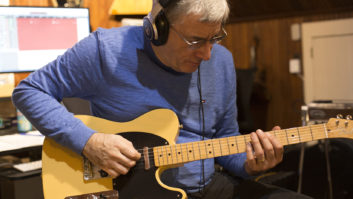The Fade-out. It was once ubiquitous and is now almost as rare as a whooping crane, a snow leopard, or even a large-antlered muntjac. Okay, maybe I’m exaggerating, but without question, fades were heard much more frequently back in the “the day”—which refers in this case to the ‘60s, ’70s, ’80s, ‘90s, and into the early 2000s. During those years, the fade was the most common ending you’d hear on a hit song.
During their heyday, fades were often employed to keep songs under three minutes for radio and to give the radio DJ a clue that the song was soon ending. But they were also an easy cop-out when the artist or arranger couldn’t figure out a good ending. Songs that faded on an album usually had to be rearranged for live performance to include a hard ending, as fades are rarely attempted in live performance. It’s funny, I’ve always liked the idea of trying to do live fades, but whenever I’ve suggested it in various musical situations over the years, everyone looks at me like I’m nuts. But I digress…
Read more Mix Blog Studio: Is Your EQ Smarter Than You?
One of the most extended fades of all time is at the end of the Beatles’ “Hey Jude.” Three minutes straight of the “na, na, na, nananana” repeating over and over while fading out ever so slowly. I’m a big Beatles fan, but that was a bit excessive—not because of the long fade, but the endless repetition.
Much more creative, in my humble opinion, is the ending of “A Day in the Life,” with its final piano chord ringing out almost endlessly, and then silence, and then the laughing and odd looped voices that come back in and then fade out. The Beach Boys’ “Caroline No,” from Pet Sounds, is another interesting one, fading out and then fading back in with the sound of a train going by and dogs barking, and then fading out once again.
Not being at all expert about the history of the fade-out, I did a little Googling and discovered that a music technology writer named Bill Weir has done a ton of research on the subject.
He wrote a definitive article on the decline of the fade in Slate.com in 2014. Weir and his research were also featured heavily in an entertaining and informative video from Vox.com. Perhaps the most fascinating fact that Weir dug up was about the first known use of the fade-out. It wasn’t in a recording, but in a live performance back in 1918! It occurred in a concert where composer Gustav Holst was conducting his famous work The Planets. In the Slate article, Weir describes what happened.
For the “Neptune” section of The Planets, Holst had the women’s choir sing in a room offstage. Toward the end, he instructed, the door should be closed very slowly: “This bar is to be repeated until the sound is lost in the distance.” Given the subject matter—Neptune was thought to be the most distant planet in the solar system—Holst’s attempt to conjure the remoteness of the planet and the mysteries of the cosmos makes sense.
One of the main conclusions in the Vox video is that it would be nice if the fade could make a comeback. I certainly agree with that. I don’t think anyone wants it to be used as often as it once was, but it would be nice to be able to use one for artistic purposes without feeling like you’ve committed a cultural faux pas.







